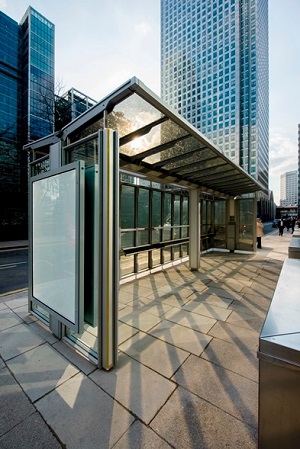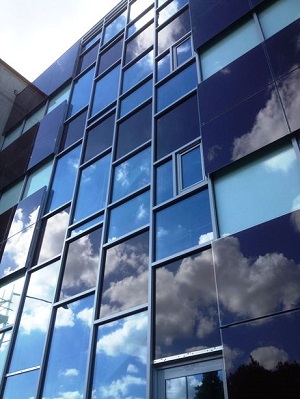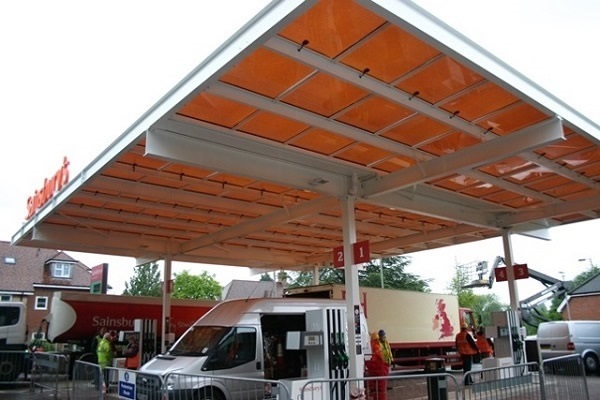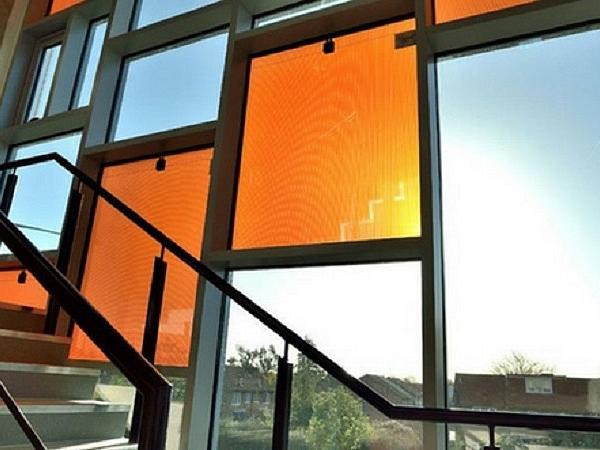In multi-storey buildings where roof space is often limited, façades and windows usually offer the most potential for electricity generation, thus the development of solar glazing is set to play an important role in the growth of ‘urban micro-generation’.
As well as being aesthetically pleasing and visually innovative, solar glass can improve the return on investment from the building, the more so if the product used is MCS certified and thus able to qualify for the Feed-in Tariff.
Transparency varies from 0% (fully opaque) to 50%, with a choice of colours / aesthetics on offer.
Applications
Solar glass can be used in many ‘BIPV’ (Building Integrated PhotoVoltaic) applications:
- translucent or semi-transparent windows;
- rain screens, curtain walling, rear-ventilated facades;
- solar protection fins and louvres;
- atriums, skylights;
- privacy protection panels;
- balustrades and fencing;
- greenhouses;
- bus shelters;
- barns with transparent solar roofs.
Solar glass is multi-functional

The design of any building integrated solar system (BIPV) needs to optimise solar energy generation whilst complying with Building Regulations, meeting the desired aesthetic, meeting economic constraints and allowing for future maintenance.
Solar glazing can achieve the following functionalities:
1) Solar electricity generation
The obvious functionality is the ability to generate electricity, even from vertical and sloped facades, and other sub-optimal environments. The profile of electricity generation needs to be modelled for the given situation. It will depend primarily on latitude, orientation, temperature/ventilation and shading.
2) Achieving target light transmission levels, shading and glare control
Solar glazing can achieve light transmission levels of between 0% and 50%. The product provides shading and glare control. Thin-film modules may absorb UV wavelength, reducing bleaching and other degradation.
Achievement of ‘semi-transparency’ depends on the underlying technology:
- crystalline cells: light transmission is adjusted by altering the spacing between the cells;
- thin-film cells: partially remove the active layer to allow the light to pass through or (better), use an ultra thin-film deposition of the active solar materials as well as two layers of transparent conductive coatings.
3) Weather proofing, structural integrity
Solar modules can provide rain-proofing, wind-proofing, wind load resistance and ageing resistance.
4) Structural strength
As most solar glazing is laminated, it tends to meet the structural and safety requirements of overhead glazing. Where additional strength is required, strengthened back glass or triple lamination can be used.
5) Sound protection
Solar facades and modules possess sound insulating properties thanks to their multi-layer structure. Sound insulation can be adjusted by increasing the thickness of the glazing and by using asynchronous cover layers or specific intermediate layers, such as polycarbonate.
6) Thermal control: thermal insulation, reduction in thermal gain
The temperature of a photovoltaic module can increase significantly when the module is exposed to radiation. The heat that the modules then radiate into the environment can be harnessed to provide heating or can be utilized to enhance passive ventilation systems.
Depending on their thickness, the multilayer glass structures of PV modules can be used to provide thermal insulation. In addition, most solar modules can also be integrated into insulation double or triple glazing structures. U-values can be as low as 1.2W/m2K or 0.9W m2K (argon-filled).
Solar naturally reduces heat gain by a combination of shading and absorption, converting some photons to electricity. In addition, the conductive coatings on the glass in transparent thin-film modules may reflect the infra-red light spectrum in a similar manner to the low emissivity glass used in conventional commercial office windows. This reduces thermal gain and reflects heat back within the building in winter.
7) Aesthetic
Solar glazing is invariably visually exciting and innovative. Different colours and effects are available depending on the product chosen.
Types of Solar Glass

As with standard roof-mounted solar panels, there are two types of solar glass available, performing in line with their non-building integrated counterparts:
- crystalline cells (monocrystalline or polycrystalline);
- thin-film (e.g. amorphous silicon, cadmium telluride).
Crystalline technologies generally provide the highest ‘STC’ (standard test conditions) efficiency values, between 12% and 17% for multicrystalline modules and up to 20% for monocrystalline modules.
The STC efficiency of thin-film technologies typically ranges from 6% - 8% for amorphous silicon up to 13% for CIS modules.
However ‘standard test conditions’ – radiation of 1000W per square metre at a temperature of 25°C – rarely apply in reality, and the STC efficiency does not necessarily reflect the yield, or energy output that can be derived from these modules over a year in a given location or position.
Thin-film technologies tend to operate optimally at 700- 800 W/m2 radiance and continue working down to very low radiance levels: ~10% sunlight.
Unlike crystalline modules which require direct sunlight, thin-film works in ambient and reflected light, on the dullest days. Thin-film exhibits less degradation than crystalline cells do at high temperatures.
The performance differentiation in different light levels and temperatures should be considered with reference to the geographic location of the project, the local climate, the orientation of the panels on the building, and the application.
PV panels on a vertical façade will receive lower light levels than those optimally angled on a roof. Equally those facing North will receive less direct light than those facing South.
The advantages of thin film are set out on our dedicated ‘thin-film’ page (under Why Thin Film?).

For more information
For more information on our recommended solar glazing products, click here.


